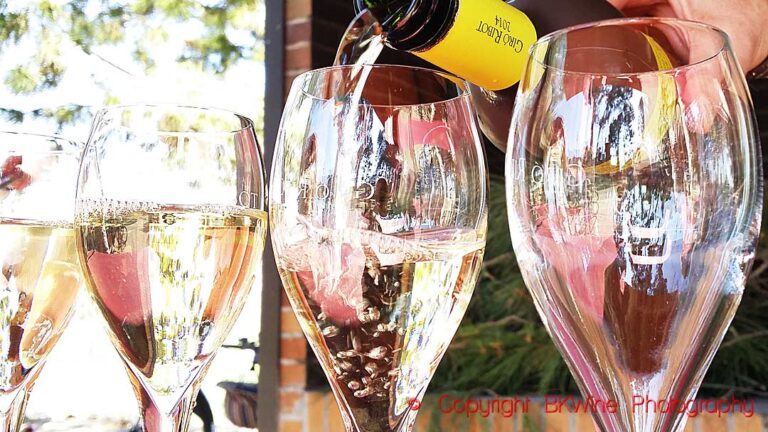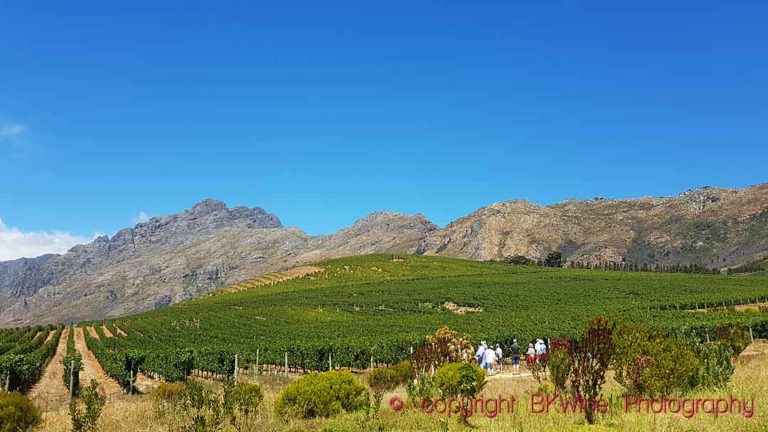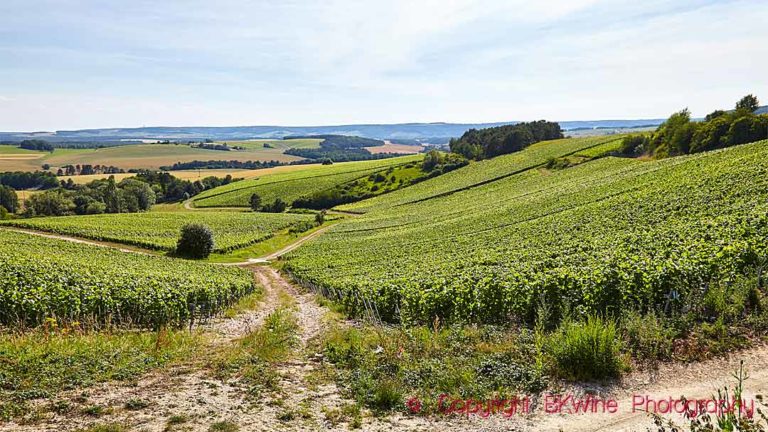BKWine judges the annual wine competition for white Bordeaux. And an intro to the Entre deux Mers appellation
We tasted several exciting white Bordeaux wines from Entre-deux-Mers competition recently. BKWine was one of the judges in the Top Vin competition which is organized every year. Here is a brief introduction to Entre-deux-Mers, and a selection of the best wines in the competition.
In the mid-1900s there was more white wine than red wine made in Bordeaux. Today 80% is red wine and only 20% white wine. It is a pity that the production of white Bordeaux wines have fallen so much. Presumably it has to do with that demand has dropped. The market for Bordeaux wine sometimes seem dominated by a handful of exclusive, famous, but for most people inaccessible chateaux. Virtually all red. It is a pity.
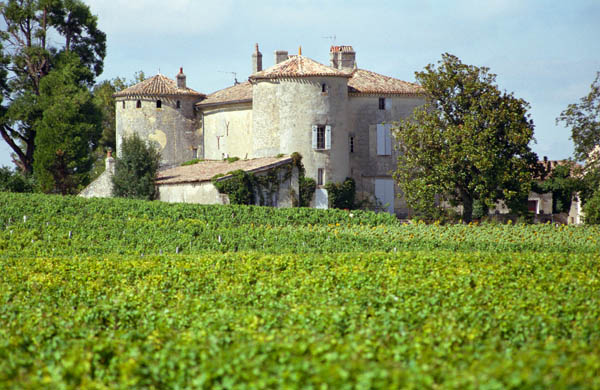
There is a wide range of white wines in Bordeaux. Everything from the very exclusive white from Graves and Pessac Léognan (eg Domaine de Chevalier, Chateaux Carbonnieux, Chateau Fiéuzal, etc.) to the anonymous volume wines from négociants. But it is in between these two groups that perhaps the most exciting white wines are available, those that are not overly expensive but still have a lot of character and individuality.
It is in this “mid-range” that we can find wines that you can buy without too dramatically breaking the bank. Many of these wines come from Entre-deux-Mers, the area between the rivers Garonne and Dordogne.
Entre-deux-Mers is currently an appellation exclusively for white wines, although there are discussions under way to also allow red wines. The red wines today that are made in the area will instead be of the Bordeaux or Bordeaux Supérieur appellations. (It is doubtful that it will make it easier to sell the reds if you call them E2M. It is probably better and more internationally viable to keep the name “Bordeaux”!)

And the winner is, no, the winners are…
The Top Vin competition in Entre deux Mers is open to producers who have already bottled the latest vintage in early March (that’s why not everyone participates). There are around twenty judges, journalists and other wine professionals. BKWine was the only judge from Scandinavia.
There was not one but two winners! A draw in other words the first place:
- Chateau Lestrille (Estelle Roumage), 86% Sauvignon, 14% Muscadelle, and
- Chateau Landereau (Bruno Baylet), 40% sauvignon blanc, 20% sauvignon gris, 30% semillon, 10% muscadelle
Very close behind the winners came:
- Fleur de Ninon (Frédéric Roubineau), 55% Sauvignon, 30% sem, 15% mu
Congratulations!
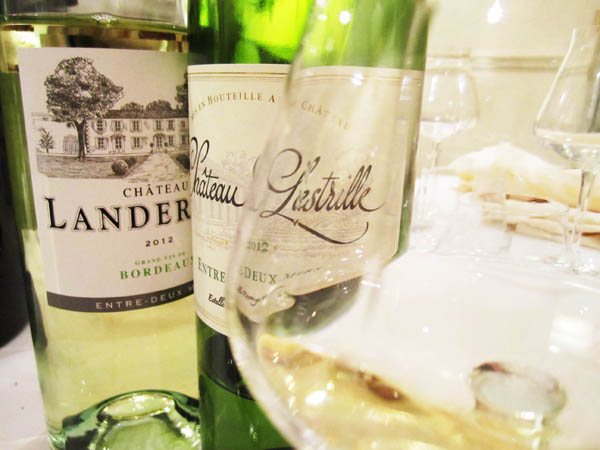
None of these wines was in the “commission” (sub-panel) that I was part of, so I tasted them only at the following lunch. But I can confirm that they are delicious wines. Chateau Lestrille, with Estelle Roumage, we know well because it is one of the chateaux that we frequently visit in Bordeaux (and because Estelle is married more Martin who is one of our wine tour guides on our wine tours!).
My own favourites among the wines that I tried (best first):
- Chateau Marjosse (Pierre Lurton), 50% Sauvignon Blanc, 15% sauvignong gris (!), 30% semillon, 5% Muscadelle – fresh, intense, long
- Chateau Vignol (Dominique Doublet), 60% sb, sg 10%, 20% sem, 10% mu – fresh with some fullness, very clean
- Chateau de Beauregard Ducourt, 85% sb, 15% sem – elegant, firm, light, very sauvignon
- Chateau Bonnet (André Lurton), 50% sb, 35% sem, 15% mu – very sb, crisp, clean, a bit short
The Entre deux Mers appellation
Entre deux Mers is the spit of land that lies between the two rivers Dordogne (on the north side) and the Garonne (on the south side). The appellation covers twelve communes: Branne, Cadillac, Carbon Blanc, Cenon, Creon, La Réole, Saint Macaire, Monségur, Pellegru, Pujols sur Dordogne, Sauveterre de Guyenne and Targon. Some of them are known for their sweet wines under their own appellations. The soil is mainly clay-limestone.
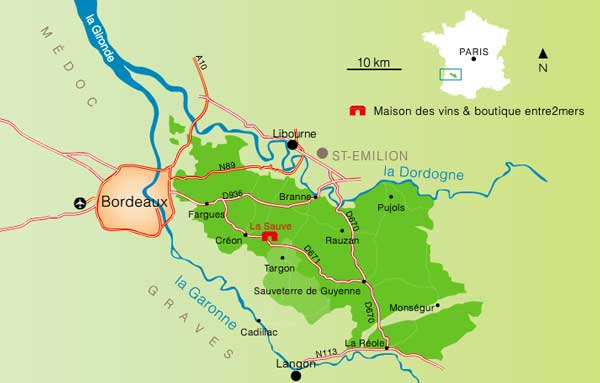
Four grape varieties
The main grape is Sauvignon Blanc with its aromatic and crisp character. It is the dominant grape in almost all wines. It must be blended with one or more other grapes. There are three other permitted grape varieties:
Sémillon, which usually makes up the second largest proportion in the blend. It gives more fullness, and is a bit flowery. Usually included with between 10% and 35%, but there are a few wines where it is over 50%.
Muscadelle, which is often included with around 10%, but sometimes not at all, and sometimes a little bit more. Adds some floral notes and elegant fruitiness.
Sauvignon gris is the fourth grape. It has started to become more popular, a trend that we hope continues because it often provides an additional interesting dimension to the wines. It is a bit richer, deeper tones, and adds extra complexity. Many of the wines that I liked in the competition had a not insignificant proportion of sauvignon gris.
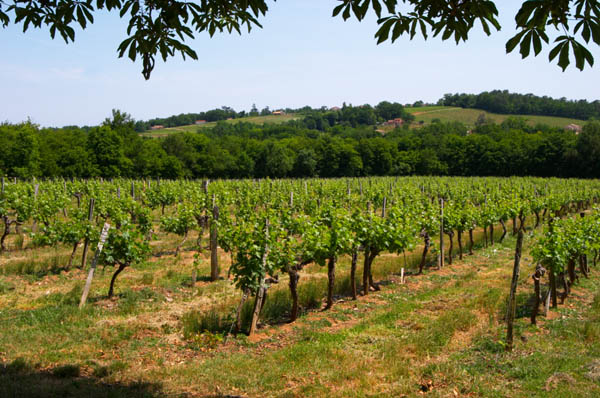
Modern vinification gives aromas
Most wines are made with careful temperature control during fermentation, often around 18 or maybe 20 degrees. This helps to maintain the freshness of the wines and to make them fresh and aromatic. Winemakers pay a lot of attention to thiol aromas (typical of sauvignon blanc), if one wants to be technical.
Most wines are given a short time for and stabilization in steel tanks, between 3 to 6 months. Those with the shortest aging are thus already bottled now in March – as illustrated by the competition. The competition only included wines from the latest vintage. Some wines are given a short time in oak barrels.
So the wines are bottled in spring or possibly early summer. Often people drink them young, when they still have the freshness and aromatic character. But, as often also with white wines (!), you can also age them for a few years, or actually several years. Then they develop completely different characters.
Entre deux Mers statistics
The Entre deux Mers appellation covers 1,285 hectares and is only used for white wines. (The geographic area Entre deux Mers covers 47 000 ha). There are 240 wine producers.
The total production is around 70,000 hectolitres, 69,227 hectolitres in 2012 and 77,025 hectolitres in 2011. Approximately 30% of the production is made by the cooperatives. This is a lot for Bordeaux, but quite normal for many other wine regions in France where cooperatives often play an important role.
Entre deux Mers has for years been struggling in the difficult economic climate. It is exactly the same situation as many other appellations in Bordeaux. Many producers have big financial problems. It is really only the most famous wine chateaux in Bordeaux that are doing well financially, around 100 to 200 “classified” chateaux (and at similar level). The 8000 or so not so fortunate wine producers often struggle to survive. One way to improve the finances of a winery is to start bottling the wine at the estate and sell the wine in bottles, “faire de la bouteille” as they say in French. Then you get to keep more of the margins compared to if you sell in bulk to négociants or supply grapes to a cooperative.
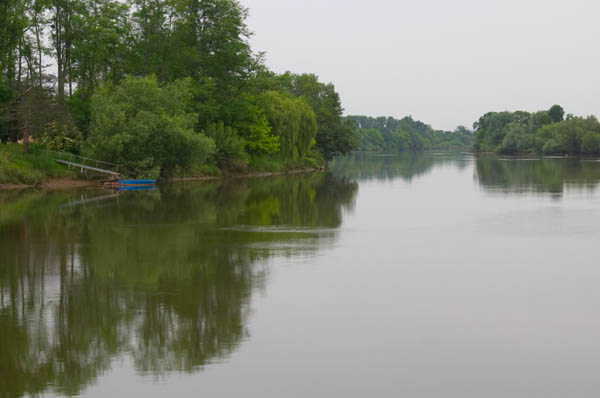
Here in the Entre deux Mers, this trend is clear. Ten years ago less than half the wines were bottled at the chateau, only 44% of the wine produced was sold in bottle from the winery. The rest was sold in bulk. Today, bottle sales stand at 73% of all wines. The trend is steadily rising.
From a consumer perspective, this is both good and bad. It is of course unfortunate that so many wine producers have difficulty surviving. On the other hand, it is also the case that there is a huge amount and variety of Bordeaux wines that are in a very reasonable price range, say between € 6 and € 15 and of very good and sometimes even excellent quality.
For Swedish consumers – or for that matter in the UK where the market is dominated by large supermarkets – it is unfortunately the case that many wine producers are “small” and therefore never have a chance to get in on the monopoly’s shelves or into the big supermarket chains. A buyer for such a large retailer often needs large volumes and most of the exciting producers, with very reasonable prices, do not sufficient volume. (See more on this below.)
34% of the production of the Entre deux Mers is sold on export evenly divided between Europe and the “rest of the world.” The largest export markets are:
- Germany
- U.S.
- Belgium
- Japan
- Switzerland
- Sweden (!)
- UK
- China (!)
Entre deux Mers in Sweden (for those with specialist interests)
According to the statistics Sweden is a surprisingly a large market for the white wines from the Entre-deux-Mers. 7% of exports go to Sweden, which means around 170,000 litres. Unfortunately, it’s basically just one single wine: Chateau Bonnet, which sells for 89 SEK bottle. But it sells a lot, around 225,000 bottles per year. This is unfortunately what often happens when there is a monopoly. The selection focuses on one or a few wines from producers who can deliver very large quantities.
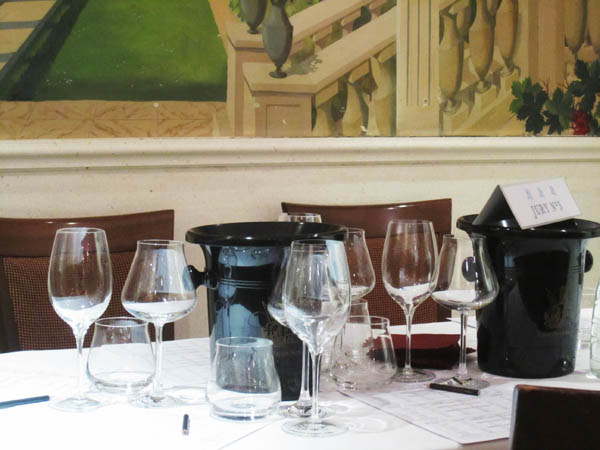
Chateau Bonnet is indeed big; they make 1 million bottles of Entre deux Mers and alone accounts for 30% of exports from the appellation. The average winery in the Entre-deux-Mers has 5.4 hectares with an average production of just under 40,000 bottles… Bonnet is certainly an excellent wine from André Lurton’s stable of chateaux. But it is still a pity that there is only one wine from the appellation in the Systembolaget range of wines.
If you go to the “on order range” managed by the wine importers and not the monopoly (but sold through the monopoly) then you can find a few more to choose from:
- Le Portail, 99.00 SEK
- Château Darzac Reserve, 106.00 SEK
- Château de Fontenille, 119.00 SEK
- Château Sainte-Marie, Réserve 109.00 SEK
- Château Maison Noble, Saint Martin, 119.00 SEK
- Château Pouchaud-Larq, 132.00 SEK
I had the opportunity to taste Chateau de Fontenille at the competition and it was certainly a very nice wine, elegant Sauvignon character with a firm and good acidity (40% sb, 20% sg, 20% sem, 20% mu) although it did not come in among the top three (if I remember correctly it actually came in fourth place). Chateau Saint Marie is a wine we have tasted a number of times at home. It is a bit lighter and less ambitious wine, but very drinkable. The others I do not know.
More on Entre deux Mers. www.vins-entre-deux-mers.com
[box type=”info”]There are lots of good Bordeaux wines to discover, from the Entre deux Mers and from other areas. Come on a wine tour to Bordeaux with BKWine and you will get plenty of opportunities to discover them.[/box]


